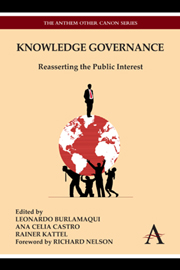Book contents
- Frontmatter
- Contents
- List of Abbreviations
- List of Tables and Figures
- Foreword
- Introduction
- Part I Knowledge Governance: Building a Framework
- 1 Knowledge Governance: An Analytical Approach and its Policy Implications
- 2 From Intellectual Property to Knowledge Governance: A Micro-founded Evolutionary Explanation
- 3 Catching Up and Knowledge Governance
- Part II Innovation, Competition Policies and Intellectual Property: Institutional Fragmentation and the Case for Better Coordination
- Part III Going Forward: Towards a Knowledge Governance Research Agenda
3 - Catching Up and Knowledge Governance
from Part I - Knowledge Governance: Building a Framework
Published online by Cambridge University Press: 05 April 2013
- Frontmatter
- Contents
- List of Abbreviations
- List of Tables and Figures
- Foreword
- Introduction
- Part I Knowledge Governance: Building a Framework
- 1 Knowledge Governance: An Analytical Approach and its Policy Implications
- 2 From Intellectual Property to Knowledge Governance: A Micro-founded Evolutionary Explanation
- 3 Catching Up and Knowledge Governance
- Part II Innovation, Competition Policies and Intellectual Property: Institutional Fragmentation and the Case for Better Coordination
- Part III Going Forward: Towards a Knowledge Governance Research Agenda
Summary
Introduction
“There are general Maxims in Trade which are assented to by every body.” So starts British Merchant, published in 1721 by Charles King. He continues, “That a Trade may be of Benefit to the Merchant and Injurious to the Body of the Nation, is one of these Maxims” (King 1721, 1). King proceeds to list varieties of trade that are either “good or bad” and thus he exemplifies perhaps the key feature of pre-Smithian economics: a taxonomic understanding of the economic world of production. The pre-Smithian taxonomy of “good” and “bad” trade was based on the observation of the obvious urban bias of economic development that was found everywhere in Europe. Somewhat ironically, the current debate about international trade is coming back not only to a similar understanding, but also images and words are reminiscent of pre-Smithian taxonomies. In essence, recent discussions about trade policy and globalization seem to come to the consensus that it is not simply the scale and scope of trade that is conducive to economic growth (as the classical post-Smithian Ricardian theory assumes), but rather the nature of trade and, more specifically, how much technological content (i.e., increasing returns activities) is traded with whom and how. That is, there is a growing understanding that trade policy is, or rather should be, a natural part of technology policies and vice versa.
- Type
- Chapter
- Information
- Knowledge GovernanceReasserting the Public Interest, pp. 49 - 78Publisher: Anthem PressPrint publication year: 2012

